What to Bring From the Dominican Republic in 2026: Dominican souvenirs
As the end of your stay at a stunning ocean view apartment in the Dominican Republic approaches, you will want to bring a few Dominican souvenirs back home. These will act as reminders of your vacation or gifts to your friends and family. If you are looking for Dominican souvenirs, Dominicana has plenty to offer. Besides, the island offers more than just souvenirs. Here you can find items that are valuable for more than their sentimental value. In this article you will find the most famous Dominican specialties.
Cacao
The cocoa bean or simply cocoa, which is also called the cacao bean or cacao, is the dried and fully fermented seed of Theobroma cacao, from which cocoa solids (a mixture of nonfat substances) and cocoa butter (the fat) can be extracted. Cocoa beans are the basis of chocolate, and Mesoamerican foods including tejate, an indigenous Mexican drink that also includes maize.
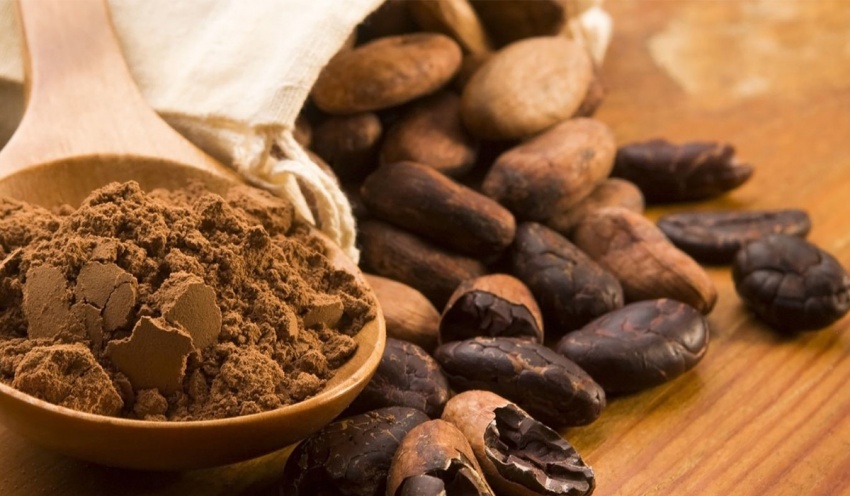
Cacao from the Dominican Republic
The word “cocoa” comes from the Spanish word cacao, which is derived from the Nahuatl word cacahuatl. The Nahuatl word, in turn, ultimately derives from the reconstructed Proto Mije-Sokean word kakawa. The term cocoa also means:
- The drink that also is commonly called hot cocoa or hot chocolate
- Cocoa powder, which is the dry powder made by grinding cocoa seeds and removing the cocoa butter from the cocoa solids, which are dark and bitter
- A mixture of cocoa powder and cocoa butter – a primitive form of chocolate.
For chocolate buffs, the Dominican Republic is the world’s top cacao producer and exporter. Probably some of the chocolate you have consumed in life is made from cacao grown in the DR. Even so, its cacao is not the best but the cacao you buy on its streets is much better than what you find back at home. Cacao beans are available from Cabarette Cacao Company, Fresh Fresh Cabarette, and the cacao man. So, if you happen to meet him, be sure to grab some high-quality cacao beans for that delightful chocolate taste.
The cacao tree is native to the Amazon Basin. It was domesticated by the Olmecs and Mokaya (Mexico and Central America). More than 4,000 years ago, it was consumed by pre-Columbian cultures along the Yucatán, including the Maya, and as far back as Olmeca civilization in spiritual ceremonies. It also grows in the foothills of the Andes in the Amazon and Orinoco basins of South America, in Colombia and Venezuela. Wild cacao still grows there. Its range may have been larger in the past; evidence of its wild range may be obscured by cultivation of the tree in these areas since long before the Spanish arrived.
As of November 2018, evidence suggests that cacao was first domesticated in equatorial South America, before being domesticated in Central America roughly 1,500 years later. Artifacts found at Santa-Ana-La Florida, in Ecuador, indicate that the Mayo-Chinchipe people were cultivating cacao as long as 5,300 years ago. Chemical analysis of residue extracted from pottery excavated at an archaeological site at Puerto Escondido, in Honduras, indicates that cocoa products were first consumed there sometime between 1500 and 1400 BC. Evidence also indicates that, long before the flavor of the cacao seed (or bean) became popular, the sweet pulp of the chocolate fruit, used in making a fermented (5% alcohol) beverage, first drew attention to the plant in the Americas. The cocoa bean was a common currency throughout Mesoamerica before the Spanish conquest.
Cacao trees grow in a limited geographical zone, of about 20° to the north and south of the Equator. Nearly 70% of the world crop today is grown in West Africa. The cacao plant was first given its botanical name by Swedish natural scientist Carl Linnaeus in his original classification of the plant kingdom, where he called it Theobroma (“food of the gods”) cacao.
Cocoa was an important commodity in pre-Columbian Mesoamerica. A Spanish soldier who was part of the conquest of Mexico by Hernán Cortés tells that when Moctezuma II, emperor of the Aztecs, dined, he took no other beverage than chocolate, served in a golden goblet. Flavored with vanilla or other spices, his chocolate was whipped into a froth that dissolved in the mouth. No fewer than 60 portions each day reportedly may have been consumed by Moctezuma II, and 2,000 more by the nobles of his court.
Chocolate was introduced to Europe by the Spaniards, and became a popular beverage by the mid-17th century. Spaniards also introduced the cacao tree into the West Indies and the Philippines. It was also introduced into the rest of Asia and into West Africa by Europeans. In the Gold Coast, modern Ghana, cacao was introduced by a Ghanaian, Tetteh Quarshie.
People around the world enjoy cocoa in many different forms, consuming more than 3 million tons of cocoa beans yearly. Once the cocoa beans have been harvested, fermented, dried and transported they are processed in several components. Processor grindings serve as the main metric for market analysis. Processing is the last phase in which consumption of the cocoa bean can be equitably compared to supply. After this step all the different components are sold across industries to many manufacturers of different types of products.
Global market share for processing has remained stable, even as grindings increase to meet demand. One of the largest processing country by volume is the Netherlands, handling around 13% of global grindings. Europe and Russia as a whole handle about 38% of the processing market. Average year after year demand growth has been just over 3% since 2008. While Europe and North America are relatively stable markets, increasing household income in developing countries is the main reason of the stable demand growth. As demand is awaited to keep growing, supply growth may slow down due to changing weather conditions in the largest cocoa production areas.
Source: wikipedia.org – Cocoa bean
Chocolate
Chocolate is a usually sweet, brown food preparation of roasted and ground cacao seeds that is made in the form of a liquid, paste, or in a block, or used as a flavoring ingredient in other foods. The earliest evidence of use traces to the Olmecs (modern day Mexico), with evidence of chocolate beverages dating to 1900 BC. The majority of Mesoamerican people made chocolate beverages, including the Maya and Aztecs. The word “chocolate” is derived from the Classical Nahuatl word chocolātl.
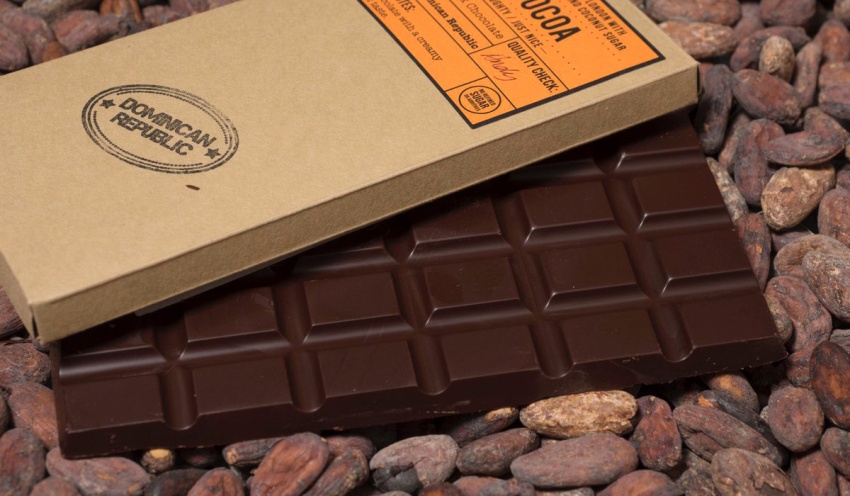
Chocolate from the Dominican Republic
The seeds of the cacao tree have an intense bitter taste and must be fermented to develop the flavor. After fermentation, the beans are dried, cleaned, and roasted. The shell is removed to produce cacao nibs, which are then ground to cocoa mass, unadulterated chocolate in rough form. Once the cocoa mass is liquefied by heating, it is called chocolate liquor. The liquor may also be cooled and processed into its two components: cocoa solids and cocoa butter. Baking chocolate, also called bitter chocolate, contains cocoa solids and cocoa butter in varying proportions, without any added sugar. Powdered baking cocoa, which contains more fiber than it contains cocoa butter, can be processed with alkali to produce dutch cocoa. Much of the chocolate consumed today is in the form of sweet chocolate, a combination of cocoa solids, cocoa butter or added vegetable oils, and sugar. Milk chocolate is sweet chocolate that additionally contains milk powder or condensed milk. White chocolate contains cocoa butter, sugar, and milk, but no cocoa solids.
Chocolate is one of the most popular food types and flavors in the world, and many foodstuffs involving chocolate exist, particularly desserts, including cakes, pudding, mousse, chocolate brownies, and chocolate chip cookies. Many candies are filled with or coated with sweetened chocolate. Chocolate bars, either made of solid chocolate or other ingredients coated in chocolate, are eaten as snacks. Gifts of chocolate molded into different shapes (such as eggs, hearts, coins) are traditional on certain Western holidays, including Christmas, Easter, Valentine’s Day, and Hanukkah. Chocolate
To make 1 kg (2.2 lb) of chocolate, about 300 to 600 beans are processed, depending on the desired cocoa content. In a factory, the beans are roasted. Next, they are cracked and then deshelled by a “winnower”. The resulting pieces of beans are called nibs. They are sometimes sold in small packages at specialty stores and markets to be used in cooking, snacking, and chocolate dishes. Since nibs are directly from the cocoa tree, they contain high amounts of theobromine. Most nibs are ground, using various methods, into a thick, creamy paste, known as chocolate liquor or cocoa paste. This “liquor” is then further processed into chocolate by mixing in (more) cocoa butter and sugar (and sometimes vanilla and lecithin as an emulsifier), and then refined, conched and tempered. Alternatively, it can be separated into cocoa powder and cocoa butter using a hydraulic press or the Broma process. This process produces around 50% cocoa butter and 50% cocoa powder. Standard cocoa powder has a fat content around 10–12%. Cocoa butter is used in chocolate bar manufacture, other confectionery, soaps, and cosmetics.
Treating with alkali produces Dutch-process cocoa powder, which is less acidic, darker, and more mellow in flavor than what is generally available in most of the world. Regular (nonalkalized) cocoa is acidic, so when cocoa is treated with an alkaline ingredient, generally potassium carbonate, the pH increases. This process can be done at various stages during manufacturing, including during nib treatment, liquor treatment, or press cake treatment.
Another process that helps develop the flavor is roasting, which can be done on the whole bean before shelling or on the nib after shelling. The time and temperature of the roast affect the result: A “low roast” produces a more acid, aromatic flavor, while a high roast gives a more intense, bitter flavor lacking complex flavor notes.
Source: wikipedia.org – Chocolate
Coffee
Coffee is a brewed drink prepared from roasted coffee beans, the seeds of berries from certain Coffea species. The genus Coffea is native to tropical Africa (specifically having its origin in Ethiopia and Sudan) and Madagascar, the Comoros, Mauritius, and Réunion in the Indian Ocean.
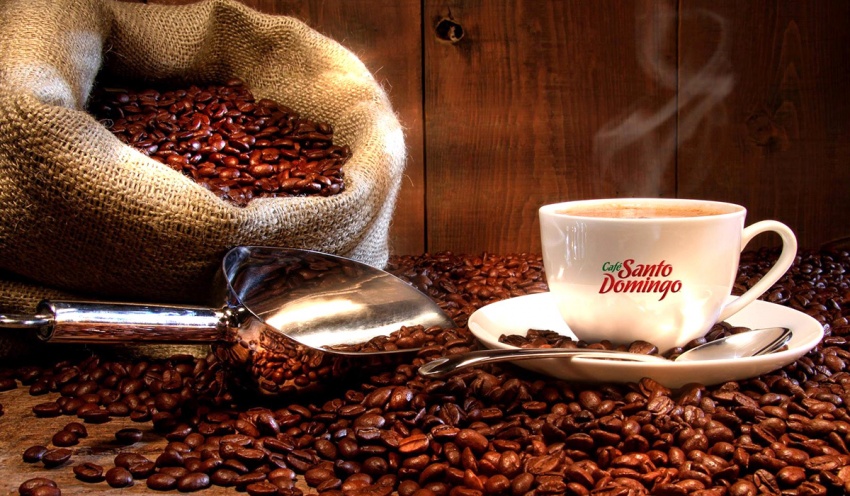
Coffee from the Dominican Republic
Coffee plants are now cultivated in over 70 countries, primarily in the equatorial regions of the Americas, Southeast Asia, Indian subcontinent, and Africa. The two most commonly grown are C. arabica and C. robusta. Once ripe, coffee berries are picked, processed, and dried. Dried coffee seeds (referred to as “beans”) are roasted to varying degrees, depending on the desired flavor. Roasted beans are ground and then brewed with near-boiling water to produce the beverage known as coffee.
Coffee is darkly colored, bitter, slightly acidic and has a stimulating effect in humans, primarily due to its caffeine content. It is one of the most popular drinks in the world, and it can be prepared and presented in a variety of ways (e.g., espresso, French press, caffè latte). It is usually served hot, although iced coffee is a popular alternative.
Clinical studies indicate that moderate coffee consumption is benign or mildly beneficial in healthy adults, with continuing research on whether long-term consumption reduces the risk of some diseases, although those long-term studies are of generally low (poor) quality.
While coffee is native to Ethiopia and Sudan, the earliest credible evidence of coffee-drinking as the modern beverage appears in modern-day Yemen in southern Arabia in the middle of the 15th century in Sufi shrines. It was in what is now Yemen that coffee seeds were first roasted and brewed in a manner similar to how it is now prepared for drinking. But the coffee seeds had to be first exported from East Africa to Yemen, as Coffea arabica is thought to have been indigenous to the former. The Yemenis obtained their coffee via Somali traders from Berbera (who in turn procured the beans from the Ethiopian Highlands) and began to cultivate the seed. By the 16th century, the drink had reached Persia, Turkey, and North Africa. From there, it spread to Europe and the rest of the world.
As of 2018, Brazil was the leading grower of coffee beans, producing one-third of the world total. Coffee is a major export commodity, being the top legal agricultural export for numerous countries. It is one of the most valuable commodities exported by developing countries. Green, unroasted coffee is one of the most traded agricultural commodities in the world. The way developed countries trade coffee with developing nations has been criticised, as well as the impact on the environment with regards to the clearing of land for coffee-growing and water use. Consequently, the markets for fair trade and organic coffee are expanding.
The word coffee appears to have been derived from the name of the region where coffee beans were first used by a herder in the 6th or 9th century (depending on author): kaffa (from the Keffa Zone in southwestern Ethiopia) derived from Kaffa Province, which was the name of the region in ancient Abyssinia. The word “coffee” entered the English language in 1582 via the Dutch koffie, borrowed from the Ottoman Turkish kahve, borrowed in turn from the Arabic qahwah. The Arabic word qahwah was traditionally held to refer to a type of wine whose etymology is given by Arab lexicographers as deriving from the verb qahiya, “to lack hunger”, in reference to the drink’s reputation as an appetite suppressant. It has also been proposed that the source may be the Proto-Central Semitic root q-h-h meaning “dark”. The term “coffee pot” dates from 1705. The expression “coffee break” was first attested in 1952.
Source: wikipedia.org – Coffee
Coffee production in the Dominican Republic is based mainly in the mountain regions of the country, in the highlands which form at least one-half of the area of Hispaniola. Introduced to the country in 1715, the Dominican Republic bean is larger and thicker than Martinique’s. The major coffee variety grown in the country is Arabica (known internationally as “mild”). Robusta is also grown but only in about 1.3% of the land area; it is consumed locally.
Coffee was first introduced in the Dominican Republic in 1715 and has been the principal crop of the small scale farmers. Coffee began to be exported circa 1872. In the early 20th century, the crop was cultivated in all the Cibao, principally in the district of Puerto Plata. The exportation of coffee from the Dominican Republic in 1900 amounted to 3,951,539 pounds (1,792,388 kg). Important coffee areas in 1918 were in Moca, Santiago and Baní, with approximately 66% of the crop exported from Puerto Plata.
The area under coffee plantation was 120,000 hectares (300,000 acres) (about 3% of land under farming), but since 1981 the area cropped has substantially declined, but the production level has remained generally the same due to the adoption of modern technological inputs. There are five major coffee producing regions, four of them being in the hilly region – the Central Mountain Region, the Northern Mountain Region, the Neyba Mountain Range, and the Bahoruco Mountain Range. There were 40,000 to 50,000 farmers operating in this sector.
In 2013, according to FAO statistics, coffee production was 10,100 short tons (9,200 t), which was about 0.1 percent of world production. It was grown in an area of 22,400 hectares (55,000 acres) with a yield of 451 kilograms (994 lb) per ha.
Source: wikipedia.org – Coffee production in the Dominican Republic
High-quality coffee is available in most Dominican shops, supermarkets, and local markets for about $5. The island’s coffee is famous globally for its high quality, full-bodied flavor, and medium to low acidity. Nonetheless, avoid waiting until you get to the airport to buy your coffee. Often, prices increase abruptly and without warning. Ideally, you should go for Induban and Santo Domingo coffee as its popularity makes it easy to obtain. Remember that whole coffee beans preserve for the longest time making them the ideal souvenir gift.
Amber
Amber is fossilized tree resin, which has been appreciated for its color and natural beauty since Neolithic times. Much valued from antiquity to the present as a gemstone, amber is made into a variety of decorative objects. Amber is used in jewelry. It has also been used as a healing agent in folk medicine.
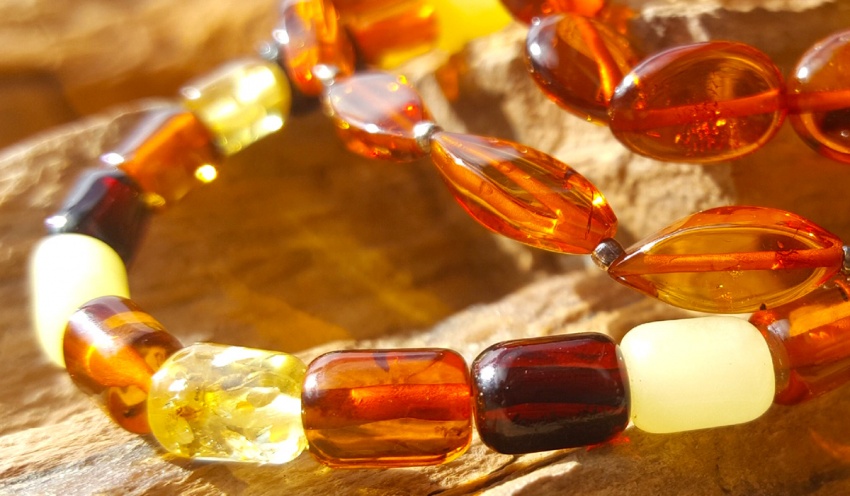
Dominican Amber
There are five classes of amber, defined on the basis of their chemical constituents. Because it originates as a soft, sticky tree resin, amber sometimes contains animal and plant material as inclusions. Amber occurring in coal seams is also called resinite, and the term ambrite is applied to that found specifically within New Zealand coal seams.
The English word amber derives from Arabic anbar (cognate with Middle Persian ambar) via Middle Latin ambar and Middle French ambre. The word was adopted in Middle English in the 14th century as referring to what is now known as ambergris (ambre gris or “grey amber”), a solid waxy substance derived from the sperm whale. In the Romance languages, the sense of the word had come to be extended to Baltic amber (fossil resin) from as early as the late 13th century. At first called white or yellow amber (ambre jaune), this meaning was adopted in English by the early 15th century. As the use of ambergris waned, this became the main sense of the word [Source].
Dominican amber is amber from the Dominican Republic. Resin from the extinct tree Hymenaea protera is the source of Dominican amber and probably of most amber found in the tropics. Dominican amber differentiates itself from Baltic amber by being nearly always transparent, and it has a higher number of fossil inclusions. This has enabled the detailed reconstruction of the ecosystem of a long-vanished tropical forest.
There are three main sites in the Dominican Republic where amber is found: La Cordillera Septentrional, in the north, and Bayaguana and Sabana de la Mar, in the east. In the northern area, the amber-bearing unit is formed of clastic rocks, washed down with sandstone fragments and other sediments that accumulated in a deltaic environment, even in water of some depth. In the eastern area, the amber is found in a sediment formation of organic-rich laminated sand, sandy clay, intercalated lignite, and as well as some solvated beds of gravel and calcarenite. Both areas seem to have been part of the same sedimentary basin but were later disrupted by movements along major faults.
Dominican amber can be found in many colors, besides the obvious amber. Yellow and honey colored are fairly common. There is also red and green in smaller quantities and the rare blue amber (fluorescent). The blue amber reportedly is found mostly in Palo Quemado mine south from La Cumbre. The Museo del Ambar Dominicano, in Puerto Plata, as well as the Amber World Museum in Santo Domingo have collections of amber specimens.
Source: wikipedia.org – Dominican amber
Larimar
Larimar, also called “Stefilia’s Stone”, is a rare blue variety of the silicate mineral pectolite found only in the Dominican Republic, in the Caribbean. Its coloration varies from white, light-blue, green-blue to deep blue.
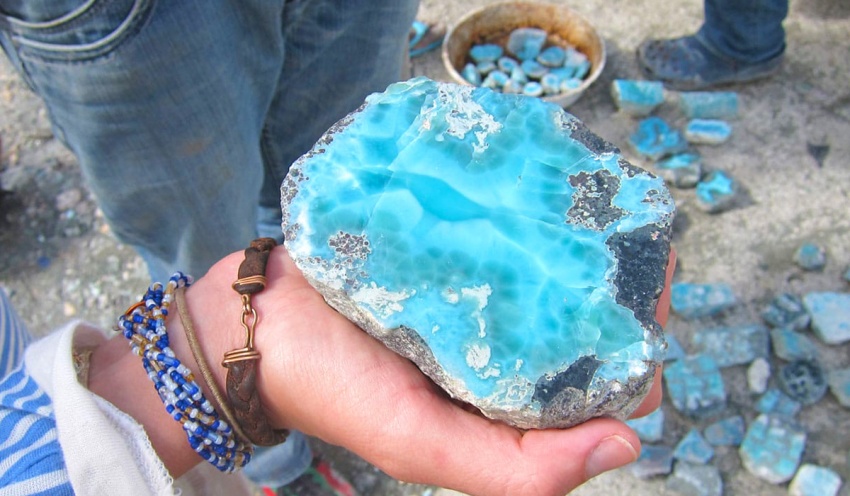
Larimar from the Dominican Republic
The Dominican Republic’s Ministry of Mining records show that Father Miguel Domingo Fuertes Loren of the Barahona Parish requested permission on 22 November 1916 to explore and exploit the mine of a certain blue rock that he had discovered. Pectolites were not yet known in the Dominican Republic, and the request was rejected.
Miguel Méndez and Peace Corps volunteer Norman Rilling rediscovered Larimar in 1974 on a beach at the foot of the Bahoruco Mountain Range, the coastal province of Barahona. Natives believed that the stone came from the sea, and they called the gem Blue Stone. Miguel took his young daughter’s name Larissa and the Spanish word for sea (mar) and formed Larimar, to suggest the colors of the Caribbean Sea where it was found. The few stones that they found were alluvial sediment, washed into the sea by the Bahoruco River. An upstream search revealed the in situ outcrops in the range and soon the Los Chupaderos mine was formed.
Larimar is a type of pectolite or a rock composed largely of pectolite, an acid silicate hydrate of calcium and sodium. Pectolite is found in many locations, but larimar has a unique volcanic blue coloration, which is the result of copper substitution for calcium.
Miocene volcanic rocks, andesites and basalts, erupted within the limestones of the south coast of the island. These rocks contained cavities or vugs which were later filled with a variety of minerals, including the blue pectolite. These pectolite cavity fillings are a secondary occurrence within the volcanic flows, dikes, and plugs. When these rocks erode, the pectolite fillings are carried down the slope to end up in the alluvium and the beach gravels. The Bahoruco River carried the pectolite-bearing sediments to the sea. The tumbling action along the streambed provided the natural polishing to the blue larimar, which makes them stand out in contrast to the dark gravels of the streambed.
Larimar jewelry is offered to the public in the Dominican Republic, and elsewhere in the Caribbean as a local speciality. Most jewelry produced is set in silver, but sometimes high-grade larimar is also set in gold.
Quality grading is according to coloration and the typical mineral crystal configuration in the stone. Larimar also comes in green and even with red spots, brown strikes, etc., due to the presence of other minerals and/or oxidation. But the more intense the blue color and the contrast in the stone, the higher and rarer is the quality. The blue color is photosensitive and fades with time if exposed to too much light and heat.
Source: wikipedia.org – Larimar
Conclusions
We hope you have found useful the information about what to bring from the Dominican Republic in 2026. Any of the above Dominican souvenirs will surely make great gifts to your friends and family. This island nation has something for everyone. However, you should begin your search early to get a better understanding of prices and other options. Doing so will help you strike better bargains with vendors. So there you are! Go ahead and grab your favorite souvenir to bring home and share your memories with family and friends!
